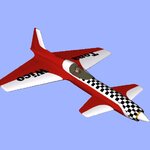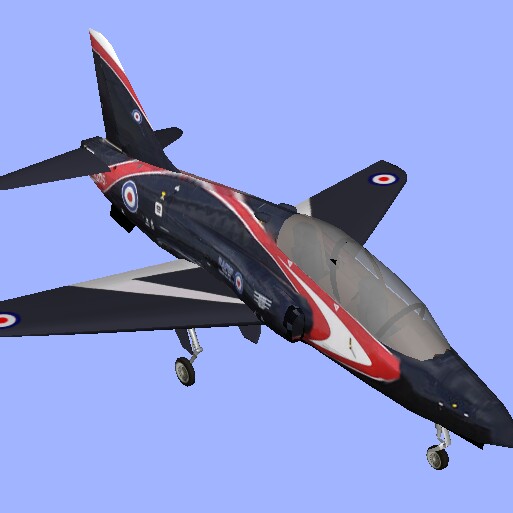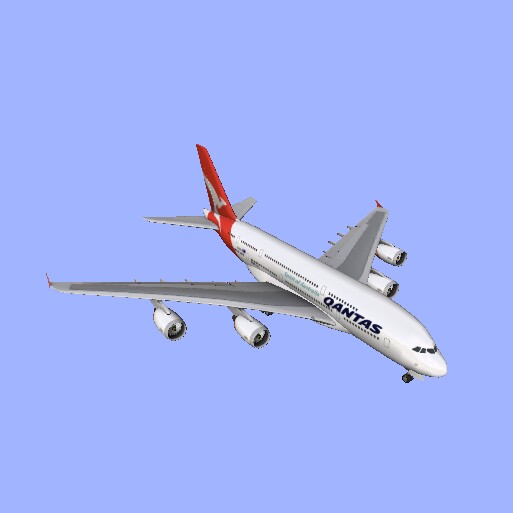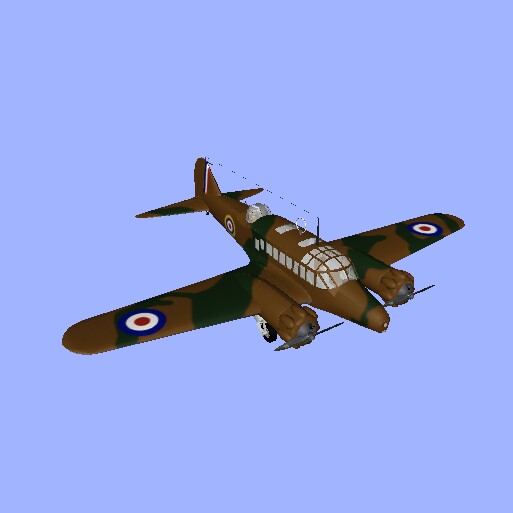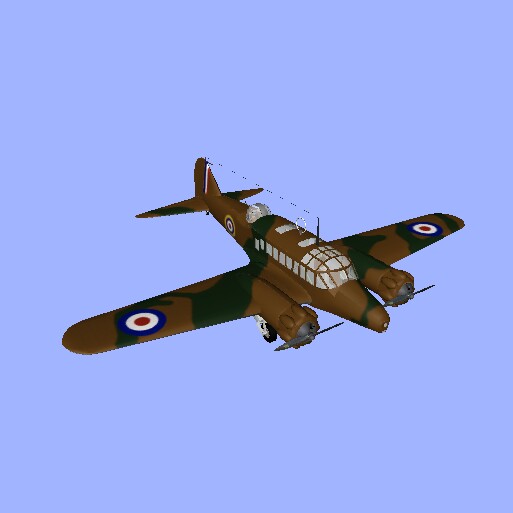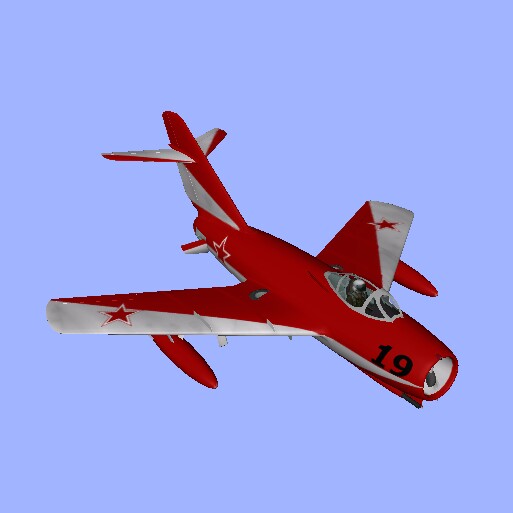The 'Tona Wico Turbine Lite' is an extremely easy to handle, 250 kph, 1.5m wingspan, 7.5kg (7kg dry) jet model powered by a derated KJ66 turbine producing just 30N of thrust. At this low power output the fuel consumption is only 78 cm^3 (78 cc) per min at full throttle, and the 560cm^3 fuel tank is good for just over 7 mins of flat-out flying. With less fuel to lug about, and lower stresses and strains on the airframe and wings, these major components can be built lighter, and the AUW of the Tona Wico Turbine Lite has been reduced from 9kg to 7.5kg wet (and from 8kg to 7kg dry), compared to the Tona Wico Turbine.
Whilst she isn't the hottest ship on the strip, she is probably one of the most satisfying - she performs all the manoeveres that one expects of a jet, without fuss or drama - in fact landings are actually very enjoyable!
Like the Tona Wico Turbine, this model has been developed from Doug Kaye's Tona Wico_EA, a model prototyped in RealFlight by Doug Kaye (DHK79) for George Miller (Katonka), who is designing a canard pattern ship, taking the basic characteristics of a Canard to a new concept.
Unfortunately, I don't have a clue about how to 'modify' the physical framework, or the overlaying graphic, to add intakes and a jet-pipe (or maybe two). I suppose the air could enter from where the spinner was (is!) - it looks OK, but Idon't know if there would be excessive intake losses and turbulence, etc.
All the controls are as per normal, but note that the rates are fixed. Wheelbrakes may be applied pushing on the stick, i.e. giving 'down' elevator. If you wind the knob all the way out, the spoilers will deploy when the throttle is fully closed, and retract when the throttle is slightly opened again, performing a very effective 'Air-Brake on Throttle' (ABoT) function. A little 'pitch-boost' has also been added to reduce stick loads when the gear is down - quite useful when landing.
Many thanks to Doug Kaye (DHK79) and George Miller (Katonka) for producing a very smart original EA (that is not a million miles away from one of Lockheed's designs that featured in the series 'Planes that Never Flew', the L-133, an aircraft designed to break the Sound Barrier before Pearl Harbor! It would have been America's first jet fighter).
Nigel_B
L133 - Specification (Proposed):
Engines: 2x Lockheed L1000 J37 Axial-flow Turbojets
Wing Span: 46 ft 8 in
Length: 48 ft 4 in
Height: ???
Weight: ???
Max Speed: Mach 0.94
Ceiling: 50,000 f
Range: ???
Crew: 1
Armament: 4 x 20 mm cannons concentrated in the nose.
L-133 History:
Towards the end of 1940, the Lockheed Aircraft Company believed that a radical new approach was required to produce a fundamentally different aircraft.
The company wanted to build a fighter that had such an advantage in speed and altitude that nothing made by any other country could touch.
Among their many talented engineers was Nathan Price, a designer that developed a steam turbine driving a propeller that powered and flew a Travelair Biplane in 1933 before he started working at Lockheed. He continued to develop the concept that eventually led to a gas-turbine jet-propulsion engine. More people were added to the job of working out the details of this engine and of course an airframe to put it in.
Finally a formal proposal was made to the Army Air Corp in February 1942. It described a Mach 0.94 aircraft capable of flying at 50,000 ft. The L-133 was to be a canard single seater aircraft powered by two of the L-1000 axial-flow engine. It length was to be 48 ft. and 4 in. and a span of 46 ft. 8 in. Armament was planned to be four 20 mm cannons concentrated in the nose.
Besides it's speed, other unique concepts were boundary-layer control and reaction thrust roll control.
Rather than be impressed the Air Corp was nearly horrified! It told Lockheed to stop wasting time and to build more P-38 Lightings. At thispoint in time, and because of their lack of experience, the American military planners were still thinking that defending aircraft would be fighting incoming bombers at 10,000 feet and so need not to go much faster than 400 mph.
Lockheed was unaware, at the time, that the Air Corp knew about the progress of other turbine engines and was trying to control the overall development of this type of engine in the US. In fact, H.P Hibbard, Lockheed VP of Engineering, only gave the go ahead for this project because he felt that his company would be alone with this 600 mph class of aircraft.
Although the L-133 aircraft was not built does not mean it never contributed to the wealth of aeronautical information. If one notices, it has the same wing outline as the P-80 Shooting Star Lockheed did build a few years later. One reason that the P-80 was able to be constructed and flown so quickly was because the engineers could draw from their previous work on the L-133.
And whilst the L-133 aircraft was neverconstructed, the L-1000 engine was. It was one of the most powerful and efficient engines of its time. Construction was started during the war, but Lockheed gave up on its development testing and permitted the Menasco Engine Manufacturing Co. to continue with it so it could concentrate on other projects. It turned out to be a handful for Menasco and the XJ-37 as it was now called wound up at Wright Aeronautical Corp. for testing until nearly 1950. The engine finally came to rest in a corner of Chino's Planes of Fame museum in California.
The Lockheed company was the first in the USA to start work on a jet powered aircraft, the L-133. Design started in 1939 as a number of "Paper Project" by engineers Clarence R "Kelly" Johnson and Hall J Hibbard. By 1940 preliminary work on a company financed jet fighter had been started, which progressed to several different versions on the drawing board. Meanwhile, Lockheed were working on an axial-flow turbojet of their own design, the L-1000, which was intended to power the culmination of the fighter project; the Model L-133-02-01
The L-133 was a single seat, cannard design, powered by two L-1000 engines. The design was noticed by the USAAF, but they showed no great interested in the idea of a jet powered fighter at the time, and missed the opportunity of giving the USA a lead in this new technology. Without the support (and money) of the USAAF, work on the L-133 fighter and it's engine the L-1000 came to a halt.
However, when the USAAF began to show interest in the idea of a jet powered combat aircraft in 1942, spurred on by intelligence reports of the advances in jet propulsion by the Germans and British, the USAAF to Lockheed for it's first jet powered fighter; the Lockheed P-80 "Shooting Star"
Towards the end of 1940, the Lockheed Aircraft Company believed that a radical new approach was required to produce a fundamentally different aircraft. The company wanted to build a fighter that had such an advantage in speed and altitude that nothing made by any other country could touch.
As early at the late 1930s, engineers at Lockheed Aircraft saw the potential of jet propulsion and began preliminary work on designs for a jet-powered combat aircraft. By 1942, they had laid the groundwork for the L-133, a single-seat canard-style fighter to be powered by two L-1000 axial-flow jet engines -- also of Lockheed design. However, the Army Air Corps saw little potential for jet propulsion and, without U.S. Government funding, the project collapsed. It wasn't until several years later, when word of Germany's success on jet propulsion began to make its way to the Allies, that Lockheed had enough funding to get back into the jet-fighter business.
Whilst she isn't the hottest ship on the strip, she is probably one of the most satisfying - she performs all the manoeveres that one expects of a jet, without fuss or drama - in fact landings are actually very enjoyable!
Like the Tona Wico Turbine, this model has been developed from Doug Kaye's Tona Wico_EA, a model prototyped in RealFlight by Doug Kaye (DHK79) for George Miller (Katonka), who is designing a canard pattern ship, taking the basic characteristics of a Canard to a new concept.
Unfortunately, I don't have a clue about how to 'modify' the physical framework, or the overlaying graphic, to add intakes and a jet-pipe (or maybe two). I suppose the air could enter from where the spinner was (is!) - it looks OK, but Idon't know if there would be excessive intake losses and turbulence, etc.
All the controls are as per normal, but note that the rates are fixed. Wheelbrakes may be applied pushing on the stick, i.e. giving 'down' elevator. If you wind the knob all the way out, the spoilers will deploy when the throttle is fully closed, and retract when the throttle is slightly opened again, performing a very effective 'Air-Brake on Throttle' (ABoT) function. A little 'pitch-boost' has also been added to reduce stick loads when the gear is down - quite useful when landing.
Many thanks to Doug Kaye (DHK79) and George Miller (Katonka) for producing a very smart original EA (that is not a million miles away from one of Lockheed's designs that featured in the series 'Planes that Never Flew', the L-133, an aircraft designed to break the Sound Barrier before Pearl Harbor! It would have been America's first jet fighter).
Nigel_B
L133 - Specification (Proposed):
Engines: 2x Lockheed L1000 J37 Axial-flow Turbojets
Wing Span: 46 ft 8 in
Length: 48 ft 4 in
Height: ???
Weight: ???
Max Speed: Mach 0.94
Ceiling: 50,000 f
Range: ???
Crew: 1
Armament: 4 x 20 mm cannons concentrated in the nose.
L-133 History:
Towards the end of 1940, the Lockheed Aircraft Company believed that a radical new approach was required to produce a fundamentally different aircraft.
The company wanted to build a fighter that had such an advantage in speed and altitude that nothing made by any other country could touch.
Among their many talented engineers was Nathan Price, a designer that developed a steam turbine driving a propeller that powered and flew a Travelair Biplane in 1933 before he started working at Lockheed. He continued to develop the concept that eventually led to a gas-turbine jet-propulsion engine. More people were added to the job of working out the details of this engine and of course an airframe to put it in.
Finally a formal proposal was made to the Army Air Corp in February 1942. It described a Mach 0.94 aircraft capable of flying at 50,000 ft. The L-133 was to be a canard single seater aircraft powered by two of the L-1000 axial-flow engine. It length was to be 48 ft. and 4 in. and a span of 46 ft. 8 in. Armament was planned to be four 20 mm cannons concentrated in the nose.
Besides it's speed, other unique concepts were boundary-layer control and reaction thrust roll control.
Rather than be impressed the Air Corp was nearly horrified! It told Lockheed to stop wasting time and to build more P-38 Lightings. At thispoint in time, and because of their lack of experience, the American military planners were still thinking that defending aircraft would be fighting incoming bombers at 10,000 feet and so need not to go much faster than 400 mph.
Lockheed was unaware, at the time, that the Air Corp knew about the progress of other turbine engines and was trying to control the overall development of this type of engine in the US. In fact, H.P Hibbard, Lockheed VP of Engineering, only gave the go ahead for this project because he felt that his company would be alone with this 600 mph class of aircraft.
Although the L-133 aircraft was not built does not mean it never contributed to the wealth of aeronautical information. If one notices, it has the same wing outline as the P-80 Shooting Star Lockheed did build a few years later. One reason that the P-80 was able to be constructed and flown so quickly was because the engineers could draw from their previous work on the L-133.
And whilst the L-133 aircraft was neverconstructed, the L-1000 engine was. It was one of the most powerful and efficient engines of its time. Construction was started during the war, but Lockheed gave up on its development testing and permitted the Menasco Engine Manufacturing Co. to continue with it so it could concentrate on other projects. It turned out to be a handful for Menasco and the XJ-37 as it was now called wound up at Wright Aeronautical Corp. for testing until nearly 1950. The engine finally came to rest in a corner of Chino's Planes of Fame museum in California.
The Lockheed company was the first in the USA to start work on a jet powered aircraft, the L-133. Design started in 1939 as a number of "Paper Project" by engineers Clarence R "Kelly" Johnson and Hall J Hibbard. By 1940 preliminary work on a company financed jet fighter had been started, which progressed to several different versions on the drawing board. Meanwhile, Lockheed were working on an axial-flow turbojet of their own design, the L-1000, which was intended to power the culmination of the fighter project; the Model L-133-02-01
The L-133 was a single seat, cannard design, powered by two L-1000 engines. The design was noticed by the USAAF, but they showed no great interested in the idea of a jet powered fighter at the time, and missed the opportunity of giving the USA a lead in this new technology. Without the support (and money) of the USAAF, work on the L-133 fighter and it's engine the L-1000 came to a halt.
However, when the USAAF began to show interest in the idea of a jet powered combat aircraft in 1942, spurred on by intelligence reports of the advances in jet propulsion by the Germans and British, the USAAF to Lockheed for it's first jet powered fighter; the Lockheed P-80 "Shooting Star"
Towards the end of 1940, the Lockheed Aircraft Company believed that a radical new approach was required to produce a fundamentally different aircraft. The company wanted to build a fighter that had such an advantage in speed and altitude that nothing made by any other country could touch.
As early at the late 1930s, engineers at Lockheed Aircraft saw the potential of jet propulsion and began preliminary work on designs for a jet-powered combat aircraft. By 1942, they had laid the groundwork for the L-133, a single-seat canard-style fighter to be powered by two L-1000 axial-flow jet engines -- also of Lockheed design. However, the Army Air Corps saw little potential for jet propulsion and, without U.S. Government funding, the project collapsed. It wasn't until several years later, when word of Germany's success on jet propulsion began to make its way to the Allies, that Lockheed had enough funding to get back into the jet-fighter business.


